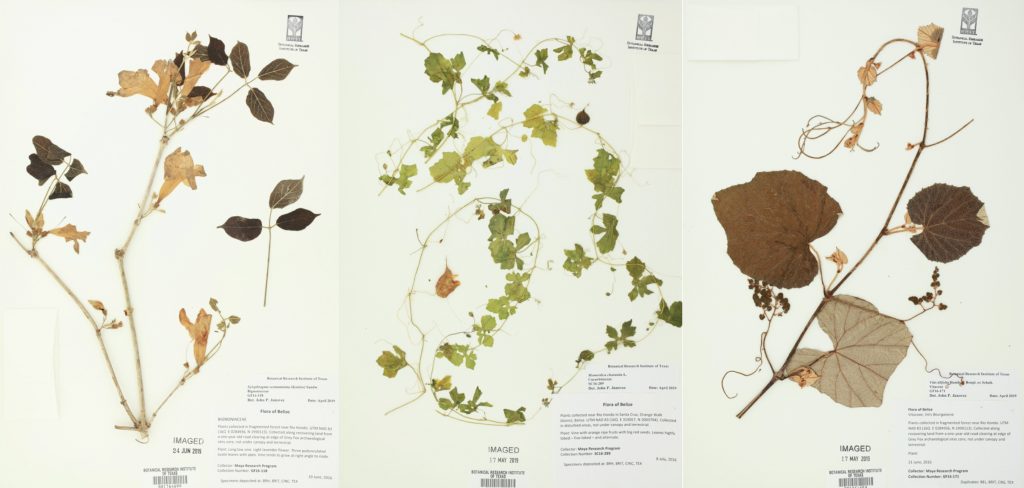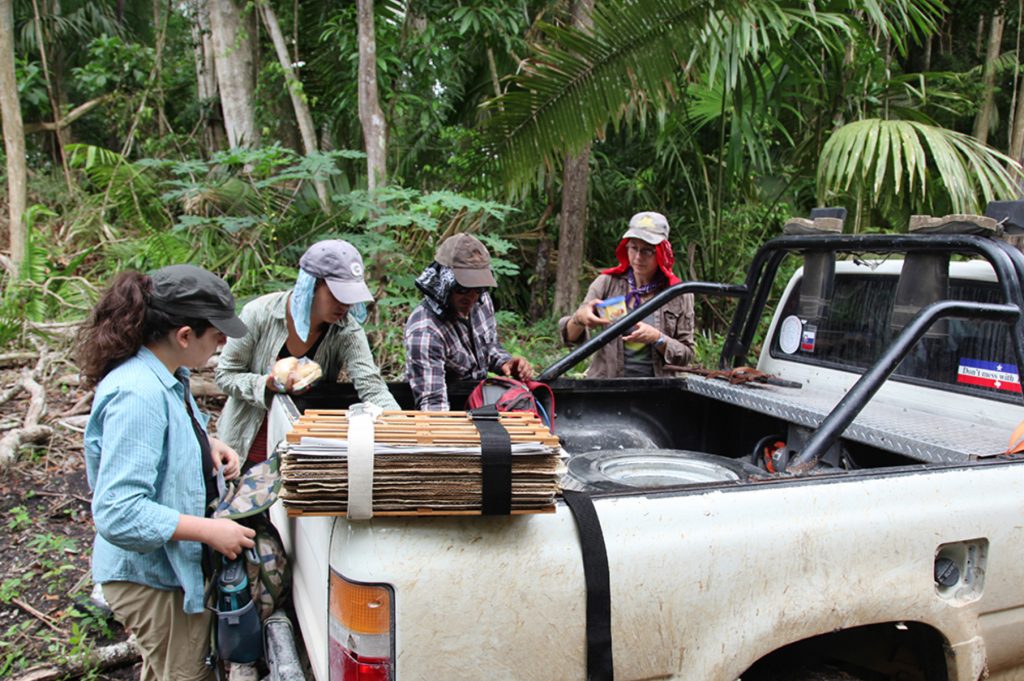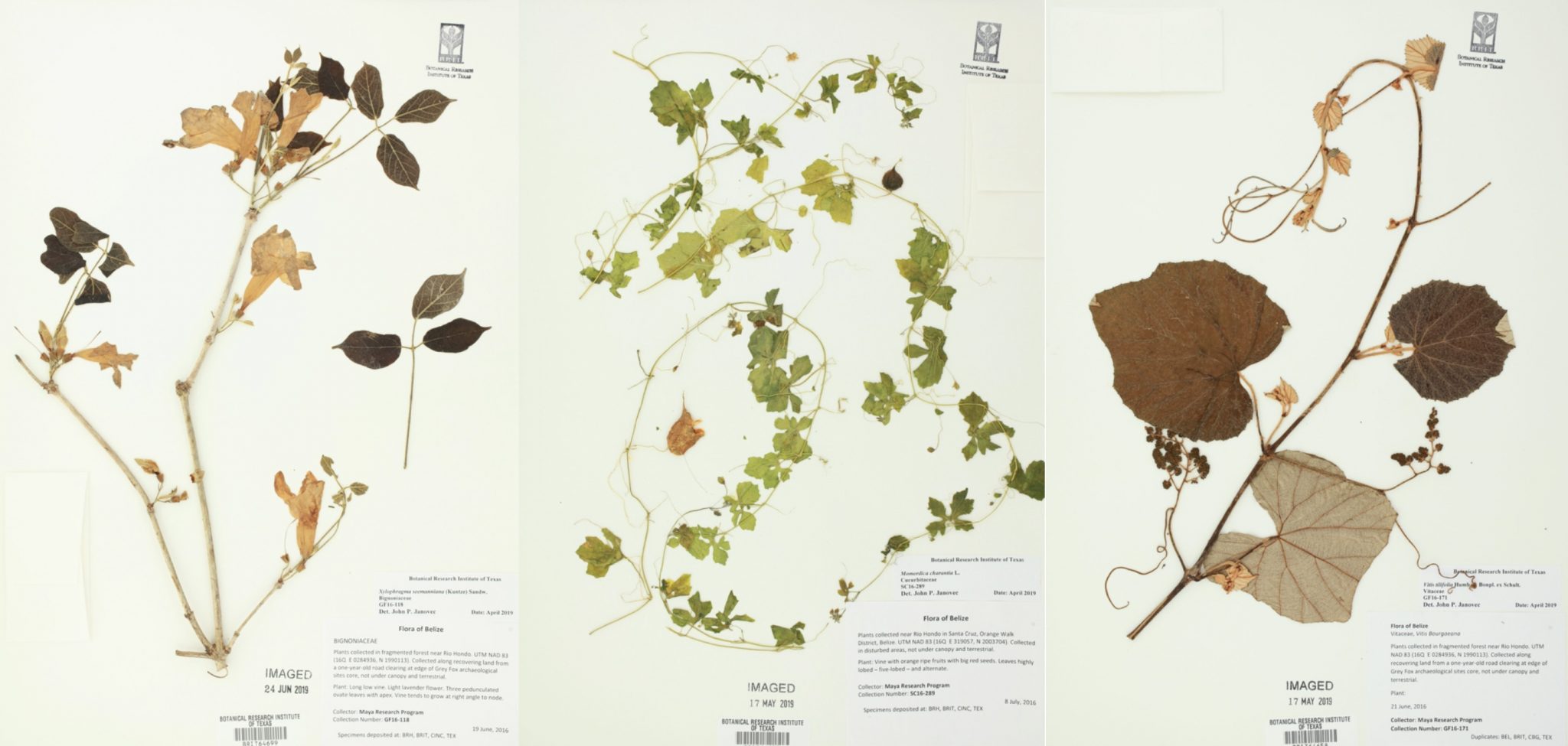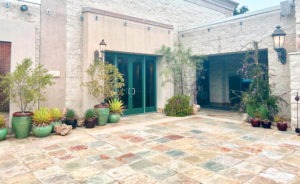Grace Lloyd Bascopé, Ph.D.
I’m part of a non-profit called Maya Research Program (MRP). It has helped me with ethnographic fieldwork in the Yucatan for many years, but chiefly it has been the organization piloting a major archaeological research effort in the Blue Creek region of Northwestern Belize on the Mexico border. Several years ago, MRP had the very unusual opportunity to purchase an archaeological site. The site, known as Grey Fox, was well within the political sphere of ancient Blue Creek and consists of a group of temples, plazas, and other structures in the middle of a “rainforest island.” When they want to increase their pastures, the ranchers who sold us the land first open logging roads to harvest out all the mahogany and other valuable hardwoods, then bulldoze down and burn the rest in order to plant grasses and raise cattle (both grasses and cattle coming from Africa). The MRP directors didn’t want to simply plunge into excavating the Grey Fox archaeological remains in this forest remnant without knowing more about it. After all, given the frightening rate at which old growth rainforests are disappearing around the world, we wanted to learn how to be good stewards of this little island of green now surrounded by pastures. In beginning to research the site, we came to realize that since the Ancient Maya abandoned it, this land essentially hadn’t been used except for mahogany logging purposes.

As serendipity would have it, BRIT received a donor-advised bequest a number of years ago that stipulated that funds be spent towards creating a flora of Belize. Over the past several years BRIT had no one doing research in Belize, so, since I work right across the border in the Yucatan, I was asked if I knew of an appropriate project that could use the fund to fulfill the bequest. It occurred to me that I could do better than that – I could turn this grant into a win/win/win/win situation and stretch the pennies to the extreme.
From the MRP archaeologists’ perspective, mounting an effort to try to make a baseline collection of all the plants at Grey Fox and its environs would have the potential to shed light on climate changes at the archaeological sites, increase comprehension of the shifting subsistence patterns in the archaeological record, and help MRP understand how to properly manage the rich Neotropical forest island in which the sites are found. From BRIT’s perspective, the herbarium would gain a set of plants from an unrepresented region, Northwest Belize, and it would be referenced in all subsequent research publications done by MRP archaeologists, hydrologists, soil scientists, paleobotanists, and others. Very importantly, from the Belize perspective and that of the BRIT donor, the same set of plants would be properly processed and mounted, ready to be housed in the Belize National Herbarium, ready to be studied there and be part of a national flora.

So, for the years 2015–2017 I mounted a field expedition to make collections at Grey Fox and other areas around Blue Creek. I took several people with me, but was also able to train several MRP graduate students and Maya personnel who work as archaeologists for the Blue Creek team.


A Typical Day
Because archaeologists are academics, they excavate in summers when not teaching. Summers in Central America are rainy seasons, and archaeologists simply have had to learn to work around the rain. As much as anything, this involves vast yards of bright blue plastic tarpaulins to cover up dig sites when the predictable morning and afternoon showers come. Plant collecting requires tarps, too, for the copious amounts of newspapers that simply can’t get wet. So every morning at 6:30 my team gathers blue tarps, newspapers, plant presses, Write-in-the-Rain notebooks and pens, clippers, pocket knives, saws, spades, shovels, machete, big black plastic bags, a 5 gallon jug of water, a snake-bite kit including EpiPen (there are five fairly deadly types in the area), other first aid equipment, a GPS, enough DEET to ward off anything, and lunch.

We load it into a four-wheel-drive field truck for a 30-minute ride from Blue Creek base camp to the Grey Fox site. Axle-deep mud the last mile or so makes for a fun slipping and sliding experience, but the truck makes it most of the way, except for the huge tree trunk that has fallen across the ruts we are following. We carry the equipment in the rest of the way to the places we need to reach to make our collections for the day. We keep an eye on the sky, partly to try to work as long as we can before a downpour, partly because the forest is filled with a wonderful array of tropical birds, each communicating with its neighbors in full voice, and partly if you don’t watch out for spider and howler monkeys, you’ll be sorry. They tend to throw things if you get too close to their trees.

The rains start, and we scramble to get the plant presses, now three feet tall and heavy with collections, and the extra newspapers into plastic bags and safely under the tarps so they won’t get soaked, top or bottom. By the time everything is out of harm’s way and dry, we’re not. There comes a point when you are so wet, you can’t get any wetter. I watch a tarantula and a couple of huge spiders run under the blue tarps. Okay, they have a right to stay dry, too, and we are in their territory. While we sit around on a ground cloth and wait for the downpour to end, we break out lunch. When you’re hungry in the field, sandwiches still taste good even if they, too, are soaking wet.
As the rain blows by and sky begins to clear, we know what’s coming. It’s called the “bochorno,” the stultifying heat right after the rain—you can see the humidity rising up, making the air dance with evaporation. Now, with the wind gone, you can’t get cool, and even though soaking wet, you still sweat out of every pore. However, overhead, the birds are moving again. Oropendolas call, and a flock of parrots chatter by. Baby spider monkeys, the hair on their heads in disarray as though they’ve been sleeping under big leaves during the rain, start moving again. They fuss at us for still being there. A crashing sound comes from the deeper canopy, and a tapir lumbers by. To us it looks the size of a juvenile hippopotamus, but never having seen either in the wild before, we are probably exaggerating. Afternoon goes by, we finish collections for the day, pile everything back in the truck, and head back to camp. There we make sure the plant presses are taken care of—plants are in the homemade dryer, and the equipment is cleaned and stored. Then we each head for a shower, peel off soggy, completely mud-covered clothes, check for ticks, and scrub down. Now with clean clothes on, we head for dinner, and someone puts a bottle of beer in our hands. We eat and go to sleep. Five-thirty comes very early next morning.




Above, I said the project was a win/win/win/win situation, but only listed three wins. I am the last winner. At 70-something, getting to do the things I do with MRP and BRIT, working with Belize Maya who enthusiastically share their deep knowledge of the forest, and meeting eager and inspiring young scholars like the archaeology graduate students…well, I’m privileged! Grace Lloyd Bascopé
Forthcoming Publications
Bascopé, Grace Lloyd, Thomas Guderjan, and Will McClatchey. Botanical Research Institute of Texas and Maya Research Program Work Together to Help an Archaeology Project Better Interpret and Protect a Small Portion of Rain Forest. Fall 2020. Practicing Anthropology.
Kwokaa, Joshua J., Thomas H. Guderjanb, Sarah Eshlemanc, Thomas Ruhld, Justin Telepake, Timothy Beachc, Sheryl Luzzader-Beachc, Will McClatcheyf, and Grace Lloyd Bascopé. A Multimethod Approach to the Study of Classic Maya Houselots and Land Tenure: Preliminary Results from the Three Rivers Region, Belize. Fall 2020. Journal of Agriculture and Social Research.






